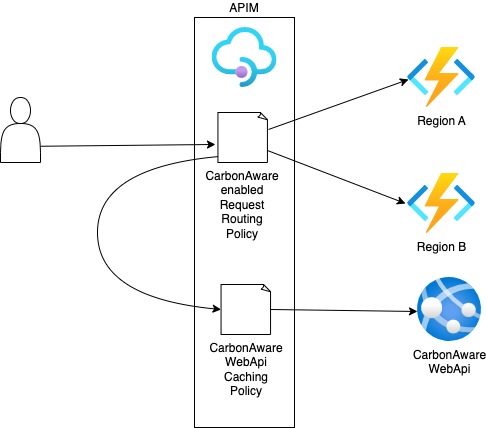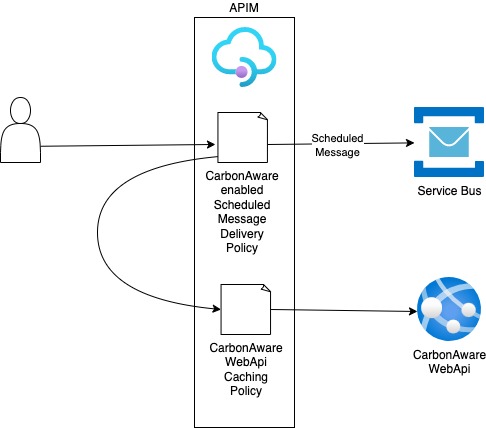Azure API Management Policy
This folder contains sample Azure API Management (APIM) policy definitions that demonstrate how to integrate the Carbon Aware SDK into APIM APIs and change the API behavior based on carbon intensity data. This sample does not cover creating a full APIM environment but focuses on how the Carbon Aware SDK can be integrated using advanced policies and policy expressions.
By integrating the Carbon Aware SDK at the API gateway level backend API's and/or downstream consumers are able to do their work at optimal carbon intensity times without any knowledge of the underlying system that determines those times. This can be especially valuable in situations where the integration is with legacy systems or systems that cannot be readily modified to include carbon awareness.
This sample includes two use cases:
In both use cases the Carbon Aware Web.Api is accessed behind an APIM API to take advantage of response caching. This allows a high volume API to use the Carbon Aware Web.Api without concerns of being throttled by the underlying services that the Carbon Aware SDK uses to provide the forecast data.
Request routing
The request routing policy sample source can be found here - request-routing-policy.xml.
Overview
The request routing use case involves an APIM policy that routes requests
based on the current carbon intensity in the target regions/data centers. In the
sample policy, requests are routed to the
backend API
in the region with the lowest carbon intensity.
This use case can be implemented in cases where requests are time sensitive and cannot take advantage of time shifting for optimal future carbon intensity usage.

Dependencies
This use case has the following dependencies:
- Azure API Management
- Carbon Aware SDK Web.Api
- represented as
my-apim-instance.azure-api.net/emissions/forecastsin the sample code
- represented as
- A backend web API deployed in multiple regions
- represented as
my-app-eastus.azurewebsites.net&my-app-westus.azurewebsites.netin the sample code
- represented as
Enhancements & considerations
This sample policy is a simple implementation to demonstrate how the Carbon Aware SDK can be integrated into APIM. A few high level enhancements and considerations are outlined below.
- Integration with hard coded regions is for demonstration purposes only and should be automated or an alternate approach for region configuration should be considered.
- It may be necessary to include other factors into the routing decision. This sample focuses purely on carbon intensity.
Scheduled message delivery
The scheduled message delivery policy sample source can be found here - scheduled-message-delivery-policy.xml.
Overview
The scheduled message delivery use case involves a policy that is carbon aware
and exposes a service bus queue through APIM. Message delivery is scheduled
based on the optimal future carbon intensity forecast. This use case is designed
for non time-sensitive workloads that can tolerate delayed processing.
This implementation takes advantage of Azure Service Bus
scheduled messages
where messages can be submitted to a queue or topic for delayed processing.
Scheduled messages don't materialize in the queue until the defined enqueue time
which is defined using the ScheduledEnqueueTimeUtc message property.

Dependencies
This sample uses the following services/components:
- Azure API Management
- Azure Service Bus
- Carbon Aware SDK Web.Api
- represented as
my-apim-instance.azure-api.net/emissions/forecastsin the sample code
- represented as
Enhancements & considerations
This sample policy is a simple implementation to demonstrate how the Carbon Aware SDK can be integrated into APIM. A few high level enhancements and considerations are outlined below.
- The specific message delivery time is based on the most optimal carbon intensity forecast value. To provide more control to the caller the request can include a time window that can be used to select the lowest carbon intensity value in the specified window.
- This sample is using an API facade on top of a service bus queue to incorporate carbon awareness. Additional response information would most likely be needed in a real world scenario.